When:
I found this photo a few years ago at an ephemera fair in London. Looking at the original below, it doesn't seem like much of a find: taken at an angle, cut down from its full size, ripped and torn at the edges.
Flipping it over, the dark patches show the remains of the album page it was stuck to - explaining the rips and tears when the seller removed it.
But there's good news too. The pencil note has enough detail that we should be able to track down this event in the day's newspapers, and find out more about the scene.
"Greyback" winning the mile, July 3/09.
Owner up.
The photo was taken on Saturday, 3 July 1909. Let's see what else we can discover.
Who:
I didn't see any mention in the newspapers from Saturday or Sunday, but three papers reported the race in detail on the following Monday. Only three horses took part:
So the three horses shown above are, in order:
Mr. Blank’s Grey Back, 169* lbs....(Owner)
Mr. F. B. Deacon's Butcher, 162++ lbs, (Owner)
Mr. H. G. Moore's Lyemun, 155 lbs. (Owner)
* Penalty of 14 lbs
++ Penalty of 10 lbs.
I wondered if "Mr. Blank" was a mistyped "Mr. Black", but checking the other newspapers they all clearly use the same "Mr. Blank". I can't find any Mr Blank mentioned on Gwulo, but looking in the 1909 Directory & Chronicle for China, Japan, Corea, Indo-China, Straits ..., there is a Mr H. de Blank listed as manager of the Pulo Samboe Tank Installation in Singapore. The names of his colleagues suggest it was a Dutch company, so that could be a clue.
The directory has better results for the other two racers:
- Deacon, Frank B., solicitor, Deacon, Looker & Deacon, Hong Kong (D, L & D was the predecessor to the modern Deacons law firm)
- Moore, H. G., lieutenant, Royal Artillery, Hongkong
They don't look to have much of an audience, just a Sikh policeman watching the end of the race, and an adult under an umbrella watching over a child playing.
The racecourse stand is out of sight behind us. It would give spectators shade from the summer sun, so hopefully there was a larger crowd there.
Where:
The newspaper reports use some interesting landmarks as they describe the progress of the race. Here's the Hong Kong Daily Press:
The start was even—Grey Back, Lyemun and Butcher, this order being maintained the greater part of the distance. The field, spread out on passing the football club stand, but bunched again at the village.
The football club marked the north end of the track, and the village marked the south end. The football club is still with us today, and at roughly the same location. The village was demolished in the 1920s though, so the only reminder of it today is its name in Happy Valley's Village Road.
The Hong Kong Telegraph:
After one false start the trio got away level with one another. Passing the spectators' stand Grey Back had the smallest of advantage of Lyemun by a neck, Butcher bringing up the rear. In processional order the field covered the next two stages of the course. Up the incline Batcher reduced his distance from Lyemun who made a plucky attempt to close with the leader with whom he drew level round the village where the trio bunched. It was difficult to tell who held the premier position in the home straight, but Grey Back had the position of advantage on the rails, whilst Lyemun was closed in between him and Butcher. Grey Back was being easily ridden and won as easily. The race for second place was a capital one, Butcher beating Lyemun by just a length.
I don't remember hearing of 'the incline' before, but it's easy enough to see what they mean. Across on the far side of the racecourse, roughly in the centre of the main photo, there is a large rock that is still clear to see today. If you look at the track you can see it had to climb up to the level of the rock, then come back down again on the other side.
Does the modern racecourse still have any incline, or has it been flattened out at some point?
What:
The large building on the left is still with us.
Today it houses St Paul's Primary Catholic School. It was originally an orphanage, known as Le Calvaire and run by the Sisters of St. Paul de Chartres. It is almost brand new in this photo, as it had only opened the previous year.
Something else to note is the relative sizes of the horses and the riders, and how different they look from modern racers.
The 1909 race was organised by the Hongkong Gymkhana Club, which was formed to "promote racing and amusements at the Happy Valley during the Off Season". Their entry requirements for this race were listed in the newspapers as:
3.30 p.m. — ONE MILE FLAT RACE — For subscription griffins of season 1908-09. Weight for inches as per scale. Winners of open race at this season's gymkhanas, or at 1909 meeting, 10 lbs. extra; two or more races 14 lbs. extra. To be ridden by owners. Pony to have been the property of rider for at least one month prior to date of entry.
Entrant fee $5. First prize: presented, 2nd prize: $25.00, 3rd prize: $10.00 (Entrance fees to go to winner)
I've been using the word "horse", but the animals in the photo are actually ponies - the difference between the two depends on the adult animal's height: 14.2 hands (appx 4' 10") or more is a horse, anything shorter is a pony.
Also in this race a pony had to be ridden by its owner, not one of the smaller and lighter professional jockeys seen on the horses at Happy Valley today.
The larger jockeys and July temperatures seem like a tough combination for the smaller pony.
Gwulo photo ID: EM004
Further reading:
Here's an example of a crowd in the Happy Valley stand on another occasion
More information, and photos of ...
- Happy Valley Racecourse [1846- ] (also see Photo 13 in Volume 4 of my books)
- Hongkong Gymkhana Club [1904-1921]
- Hong Kong Football Club
- Le Calvaire / St Paul's Primary Catholic School, Happy Valley [1907- ]
- Wong Nai Chung Village [????-1923]
Read the full reports of the race:
- p.3, Hong Kong Daily Press, 1909-07-05
- p.3, The Hong Kong Telegraph, 1909-07-05
- p.21, The Hong Kong Weekly Press, 1909-07-05
Trivia:
The rules for the race say it was only open to "subscription griffins". The Hong Kong Jockey Club's current ownership bye-laws give the following definition of a Subscription Griffin, though I'm not sure if it was the same back in 1909:
... a horse drawn in a ballot for horses purchased by the Club unraced and offered for sale to Members by subscription in accordance with the Horse Ballot Bye-laws.
The origins of the word "gymkhana":
The first element of Gymkhana comes from gend meaning ball in Hindi/Hindustani/Khariboli. This element is distinct from the English word gym, short for gymnasium and gymnastics which has Greek and Latin roots. The second element, khānā has a Persian origin, meaning a home or a compartment. In Persian, (خانه) is a term for dwelling, house. (Wikipedia)

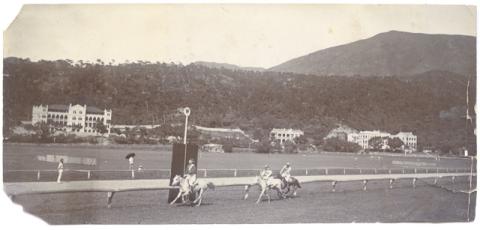

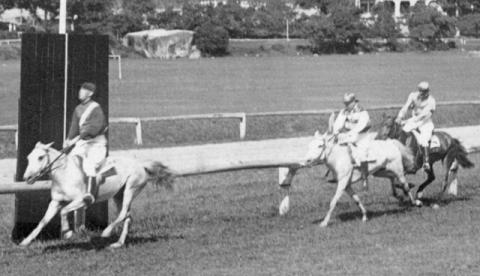
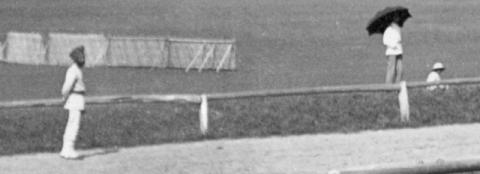

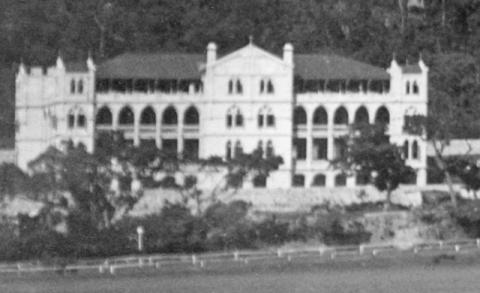
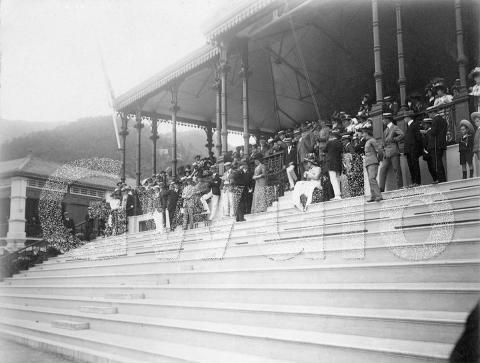
Comments
About "griffins" and "Larsens"
The following information is extracted from the SCMP 9 October 1920 but mainly adapted from excerpts from Austin Coates’s book China Races. My interest in Hong Kong's racing history relates to the years 1920-1923 when my grandfather started his own stable. David's photo is over a decade earlier, before the Larsen ponies arrived in Hong Kong:
Untrained racehorses were known as “griffins”, a word used to denote a newcomer to India or a novice. The term had been coined around 1850, so was not specifically related to Mongol ponies. Hong Kong was at the end of the receiving line of China ponies that had originated in Mongolia, the ponies being obtained in Shanghai, rather than Tientsin. The ponies were raced as “subscription griffins” and were generally regarded as inferior to owner-chosen griffins. Negative prejudice about griffins arose from the fact that a subscription griffin was a relatively cheap buy, however there were races specifically for subscription griffins, which gave their owners a chance to participate in the excitement and even to bag a win. The list of those who were lucky enough to acquire a pony from the first batch of Larsen ponies to arrive in Hong Kong in 1920 was reported in the papers.
On 9 October 1920 owners of racing ponies purchased thirty so-called Larsens. The ponies were named after Frans August Larsen, a Swedish missionary who had acted as interpreter for the negotiations between the Mongols and the Chinese over the building of a possible railway across Mongolia to speed their exports of tea to Europe. The Mongols refused the railway and were so grateful to Larsen for his part in helping them get rid of the Chinese, that they appointed him Duke of a territory of grassland in Inner Mongolia, perfect for pony breeding. The subsequent trade in Larsen ponies was initiated by a young racing fanatic, called Roy Davis, who was first approached in 1918 by a Mongol who came to visit him in his office in Tsientsin. Davis journeyed to visit Larsen to test the Mongol ponies against two of his own. Due to the extremes of the Mongolian climate and its high altitude, the endurance and strength of the Mongol ponies easily surpassed that of any horse bred in China. Davis’s ponies were roundly beaten in a ten-mile gallop, reduced from the Mongol norm of a thirty-mile flat race. Thus began the partnership between Duke Larsen and Roy Davis and the eventual arrival of pure-bred Mongol ponies in Hong Kong.
Racing Names
David refers to an owner who styled himself "Mr. Blank". It was common, but not obligatory, for owners to adopt a pseudonymous "racing name". Sir Paul Catchick Chater was simply "Sir Paul". His ponies' names usually carried the suffix "-dahlia". My grandfather, Charles Warren, used the racing name, "Mr Towers" after the name of his house. His ponies' names carried the suffix "-tile" - perhaps a form of publicity, as tiles were the main product of his company C.E. Warren & Co. I have only copied racing records from 1920-23 when my grandfather was involved in racing, but for example the owner of the pony "Flywheel" styled himself "Mr Wobble", mentioned in a racing report of 24 February, 1921. I can't remember the real name of "Mr Dynasty". I'm sure it is well known. The racing reports from February and March 1923 give Mr Dynasty's ponies as King John, King Henry, King Tommy and King Johnnie respectively. I vaguely remember either a "Mr Blank" or a "Mr No-name". The newspapers always respected the convention of racing names in their reports.
Re: Racing Names
I agree with Jill. "Mr. Blank" was likely a pseudonym. There was another owner who styled himself as "Mr. Dryasdust" in the gymkhana races.
A 1920 race record for "Mr Blank"
Happy Valley racing
There is still an incline at the Happy Valley Racecourse. It was amateur racing until 1971 when it turned professional. The "horses" were actually China ponies. My grandfather Ho Kom Tong became the first Chinese racehorse owner in 1927 and was the first Chinese owner to have a Derby winner with President Hall in 1929. All his 58 ponies registered in Hong Kong carried the suffix "Hall".
Thanks for the additional…
Thanks for the additional information about ponies and the use of pseudonyms.
I've looked at some other race reports that mention Mr Blank to see if there was anything among his ponies' names that might give a clue to who he was, but I can't see any obvious pattern:
I've written to The Hong Kong Racing Museum to see if they have any ideas.
Other results of Mr Blank's ponies
The Hong Kong Racing Museum ought to have records for owners' real names. The Jockey Club's Race Programmes give the owners' racing colours, which should prove whether the Mr Blank who was racing from 1909-1913 as above was the same Mr Blank who was racing in 1920-1923. I only have the latter race records. The racing colours of Mr Blank 1920-1922 were "Dark Blue, Light Blue sash, Maroon sleeves and cap." His ponies sometimes raced in the same races as my grandfather's but struggled to do well. I have probably missed many, but I have the following records for Mr Blank's ponies:
*1920 June 19: Rab came 11th in a field of 12. (HKDP, 21 June 1920)
* 1920 (date uncertain). Tredegar came 14th in a field of 15. (this race programme was wrongly attached to the 19 June 1920 cover)
*1920 October 9: Tredegar came 5th in a field of 6.
*1920 November 29: Hongkong Gymkhana Club Meeting. Once Round Handicap. Cranby took 3rd place in a field of 7.
* 1922? (date uncertain): Jaybird was no. 8 in a field of twelve. Handicap from the Two-mile post. Once round and In.
Mr Buxey
Sir Hormusjee Mody raced as Mr Buxey.
Today we still have Buxey Lodge at 37 Conduit Road, a Govt block of flats. On this site in 1909 Mody built a large house for himself also called Buxey Lodge.
Race reports for Mr Blank's Greyback
As Mr Blank was an owner-rider, I hoped to find his real name in one of the three race reports for Greyback, which had to be ridden by its owner in the race that it won. No luck! By the way the page number for the HKT race report is p. 4 and the page number for the HKWP is p. 26. Mr Blank also owned a horse called Mr Joseph running on the same day.
Who was Mr Blank?
Informing my (cleverer than me) husband that I was trying to discover the identity of Mr Blank for David, he replied: "was there a Mr White?" Yes indeed there was. And not only an owner, for we see that Mr H.P. White won a chestnut pony in the draw for the successful winners of subscription griffins published in the SCMP 26 September 1921. He is bottom of the list of owners published in the SCMP 27 January 1922, but has two ponies that year. White is also given as a jockey. I can see him given as riding Shek O Chief in the Grand Stakes on Champions Day, 23rd February 1922 and listed as a rider who won a 3rd place in the opening day of the Derby 21st February, 1922. Henry Percy White appears in the Jurors List of 1909 and also 1921 as a Special Juror. As Chairman of the Hong Kong Club, perhaps he preferred to have a racing name in addition to his official rather prominent personality. It will be interesting to learn what the Hong Kong Racing Museum reveals about Mr Blank. I thought I would put up Mr Henry Percy White as my candidate in the interim.
Racing Pseudonyms and "Greyback"
The Hong Kong Telegraph normally provides a good summary and account of the race meetings held at Happy Valley, particularly the Annual Races (3-day Meet which includes the Hong Kong Derby) held in February post-Chinese New Year. I looked at the Annual Races held in 1910 and 1911 for the pony "Greyback or Grey Back" and the following is extracted below:
---------------------------------------------------------------------------------------------------------------------------------------
1910
In the Garrison Cup held on 15 February 1910, the race record shows that "Greyback" was owned by "Mr. Dash" and ridden into 5th place by Morley at 11 stone 3 lbs.
"Greyback" was also raced by the same owner in the China Stakes on 16 February and the Great Southern Stakes and Consolation Stakes on 17 February respectively. The pony finished at the back of the field.
"Mr. Dash" also raced "Sunny Jim" during the Annual Races.
1911
In the Garrison Cup held on 14 February 1911, the race record shows that "Greyback" was owned by "Mr. Velox" and ridden into 4th place by Gegg at 11 stone 8 lbs.
"Greyback" only competed in one race. "Mr. Velox" did not have other runners in the Annual Races.
---------------------------------------------------------------------------------------------------------------------------------------
Was "Greyback" owned by an individual or by a syndicate? The race reports do not show information on syndicates or racing colours. "Mr. Blank" does not appear in 1910/1911, nor does "Mr. Velox" in 1910 or "Mr. Dash" in 1911. Unearthing their real names from their racing pseudonyms is going to be extremely difficult.
"Mr. Dryasdust" had runners in both 1910 and 1911. The connection made to Mr. H. P. White being "Mr. Dryasdust" can be viewed here
Mr Blank, Mr Dash and Mr Velox
I've had a quick run through of the race results for 1920-23 that I have. They are admittedly fragmentary but I haven't been able to find Mr Dryasdust. Mr H.P. White appears in his own name as one of the 45 successful owners in the draw for the new subscription griffins that arrived in November 1921. He also appears in his own name as the owner of "Merrysands", who took second place in the Consolation Stakes on Off Day, reported 26 February 1921. I will also post a list of the successful owners at the February 1922 races. It doesn't include either Mr Dryasdust or Mr Blank. Ponies changed hands very frequently and very cheaply. I wonder if Greyback was sent to auction in 1910 and again in 1911. The auctions and successful purchasers appear in the press. "Mr Dash" and "Mr Velox" don't sound terribly authentic as names - but they both connote velocity!
Transfer of Ponies
Noted a few public auctions of ponies but none involving "Greyback". Some of the auctions do not mention the winning bidder or new owner. That draws a "blank"!
Following on from Jill's…
Following on from Jill's examples I found these two lists of griffins that arrived in Hong Kong in late 1908, and may include the pony Greyback shown in the main photo above.
Subscription Griffins
Here are the subscription griffins in a table. I've crossed out any that aren't gray.
190811231BayJ. Douglas190811234BlackGeneral Broadwood190811238BayF.H. May1908112322BayR.E. Toeg1908112323BayLieut. Loheb, R.A.1908112337BayLieut. Moore, R.A.1908112350WhiteT.H. Forrest.1908112355BayLieut. Scarlet (Buffs).1908112364BlackF.B. Deacon.1908112366BayT. F. Hough.1908120325WhiteCapt. Barker (Buffs)1908120326WhiteGeneral Broadwood1908120327BayAdmiral Lambton1908120328BayA. Moir1908120329ChestnutCapt. Houblon (Buffs)1908120330ChestnutC. E. Anton1908120331WhiteLieut Leeson1908120339BayJ. R. M. Smith1908120334BlackMajor Finlay1908120336RoanMacdonald and Howarth1908120339WhiteG. Friesland1908120340BayH. P. White1908120341ChestnutW. J. Gresson1908120343WhiteJ. H. Lewis1908120346BayJ. WheeleyGrey and not so grey
In equine circles a "grey" is actually what you and I would call "white" - although I see there are "white" ponies as well. However it may explain why some of the ponies are qualified as "dark grey", "marble grey", "nutmeg grey", "iron grey" etc. The ponies arrived unbroken and still in their shaggy wild state. One owner (Dodwell?) is said to have tied one to the back of a tram to break it in. Greyback may have been a skewbald (skw). I don't know if this contingent of subscription ponies would have been race-ready by July 1909. Greyback could have been a more experienced pony from an earlier contingent. The morning gallops in advance of a race meeting were often reported by the newspapers and eagerly watched by those who wanted to know where best to place their money. It might be worth checking to see if Greyback appears in any of these.
No luck re Mr Blank's identity from the Jockey Club records?
Who was Mr Blank?
A Jockey Club Race Programme for the Second Gymkhana Meeting, believed to be for 6 May 1922 gives Mr Blank as the owner of a skewbald pony called Jaybird. The Race Programmes were printed in advance and the front cover for the 6th May meeting reads "WEATHER PERMITTING". The Jockey Club archivist who provided me with the Race Programme photocopies was uncertain what date the meeting actually took place. I haven't found it reported on 6th or 8th May, but that may be my incompetence. The SCMP report on the Gymkhana of 16 October 1922 gives Hon. Mr. P.H. Holyoak as the owner of Jaybird, which was an "Also ran" in the B Class Three Quarter Mile Race for China Ponies. That would mean only a five month gap between one owner and another and the 6th May date isn't even certain. Could Mr Holyoak, a prominent figure in the Hong Kong community, have been Mr Blank or one of the Mr Blanks?
Amendment to the above
I've now found the Hong Kong Telegraph report of the 6 May 1922 gymkhana. The above Race Programme was indeed misdated as Mr Blank's pony, Daybird, [sic] was an Also Ran in the 3-mile race for China ponies, not the Handicap: Once Round and In, which is the race for which Mr Blank's Jaybird is listed in the programme I've cited. I assume that Daybird is a misspelling for Jaybird though. More digging needed.
Is Jaybird the clue to Mr Blank's identity?
According to this excerpt from the Race Report on the Gymkhana of 3 June 1922, Mr P.H. Holyoak was the owner of the winning skewbald pony, Jaybird, less than a month after Mr Blank was given as the owner of Daybird - (presumably misspelt, as Mr Blank is given as the owner of Jaybird in a 1922 Race Programme.) Was Mr Blank actually Mr Holyoak? I don't think I've yet seen Mr Blank's name in the lists of winners of the subscription ponies, whereas Mr Holyoak's name appears at least twice in the lists uploaded on this thread. He even draws a skewbald in September 1921.
Mr Blank's pony, Ricebird
Here is Mr Blank again as the owner of the unplaced Ricebird which ran in the Extra Gymkhana of 8 July 1922. At the same gymkhana, Mr P.H. Hobhouse is given as the owner of the unplaced Jaybird and Daybird, which I now think are different ponies. All three ponies were ridden by the jockey, Mr Sewell. The clip below is from the China Mail of 10 July, 1922.
Thanks to Jill for the…
Thanks to Jill for the further digging on this mystery - my head is spinning with all the combinations! One point in Mr Holyoak's favour is that he'd arrived in Hong Kong in 1899 (see Jill's page for him at https://gwulo.com/node/59109), so he could have been racing when the original 1909 photo was taken. But, I can't say we're certain with the identification.
I'd imagined there would have been some official list or record showing the owners' pen-names and their real names, but I checked with the Hong Kong Racing Museum and they don't know of any such documents.
They didn't find any mention of "Greyback" or "Grey Back" in their records, but they did find the following horses raced by "Mr Blank" in 1921-23:
- King Harry
- Jaybird
- Ricebird
- Daybird
- Royal Earl
I'll put this on the back burner, and hope that some more clues will surface in time.
PS After having just said I'd let it drop, if we see Mr Blank mentioned after Mr Holyoak's death in May 1926, we'll know they aren't the same person.
Mr Holyoak’s racing colours
David, a couple more clues might prove whether Mr Holyoak and Mr Blank were the same. The Race Programmes give the racing colours of each owner of the ponies racing. I gave Mr Blank’s in one of my posts but I don’t have Mr Holyoak’s. The Jockey Club only gave me photocopies of the races in which my grandfather’s ponies were running. The Jockey Club archivist will also be able to find out the owner of the Bird stable. The newspapers may also contain the above info, but it will be scattered and less easy to find.
re: Mr Holyoak’s racing colours
Alas, they're different. In the Five Furlongs Handicap in the race meeting held on 8 July 1922, we have:
Racing colours
Well found, David. Of course if you wanted to be incognito on the racecourse, it wouldn’t make sense to use your own well known racing colours. I haven’t at the moment found Mr Blank in the lists of owners - but I don’t have many. My suspicious mind wonders if there was an advantage in running some ponies in a pseudonym and others not, although everyone will have known who Mr Blank was.
Winning a race February 1922
May I use this thread to stack my three "Winning a Race" photos for comparison, taken in February, July and October 1922 respectively, so that they don't get separated. Here is the pony, Mosaic Tile winning the Championship Stakes on Off Day. Off Day was reserved for ponies that hadn't won any races during Derby week. It was therefore a popular event in which the unexpected could happen.
Winning a race July 1922
This is the Tile pony, Mosaic Tile owned by Mr Towers (actually C.E. Warren) winning by a neck from Boomerang owned by F.H. Kew. The ponies are so close, it's difficult to see that there are two.
Winning a race October 1922
This close 3-horse finish was won by F.H. Kew's outsider pony, Wombat from A.G. Stephens's Hatton, the favourite, with "our" Warren pony, Mosaic Tile taking third place. Charles Warren would die in June the following year. Mosaic Tile was then bought by F.H. Kew.